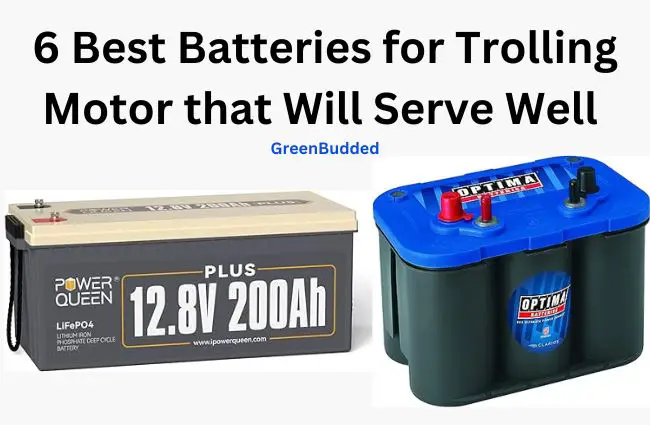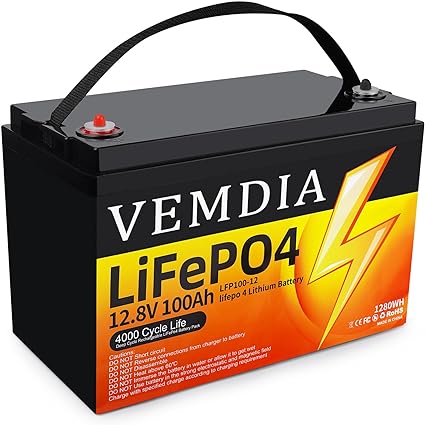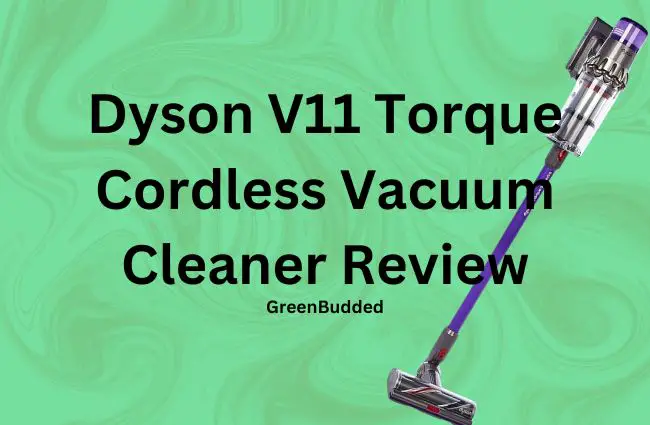Helpful Guides on each Category

Fellow anglers, choosing the best battery for your trolling motor isn’t just about avoiding embarrassment – it’s about maximizing your on-water efficiency, safeguarding your investment, and ultimately, catching more fish.
You hit the “on” switch on your trolling motor, only to be greeted by a pathetic whimper and a flickering light. The trolling motor battery, the lifeblood of your aquatic adventure, is as dead as the fish you haven’t yet caught.
For your trolling motor, the battery that provides the best output from multiple user reviews and my own experience is the Power Queen 12V 200Ah Plus LiFePO4 Battery. It is lightweight, compact and very durable.
The right battery fuels not only your trolling motor’s performance but also its longevity. A well-chosen battery unlocks smooth, silent operation, extended run times, and the confidence to explore further, cast further, and ultimately, reel in more.
Read Also: The Best Kayak Trolling Motor (4 Powerful, smooth and Quiet Choices!).
The Best Trolling Motor Batteries
- Best Overall: Power Queen 12V 200Ah Plus LiFePO4 Battery.
- Best Lithium: VEMDIA 12V 100Ah LiFePO4 Lithium Battery for trolling motor
- Best Budget: Interstate 12V DCM0035
- Best AGM Trolling Motor Battery: Deka Intimidator AGM Battery
- Best Compact: Optima Bluetop Batteries
- Best for Kayaks: Dakota Lithium 12V 23AH Deep Cycle Battery
Best Overall: Power Queen 12V Plus LiFePO4 Battery.

The Power Queen 12V 200Ah Plus LiFePO4 Battery is what has worked best on my trolling motor, not only me but many other anglers out there. It is a lightweight lithium iron phosphate (LiFePO4) battery that boasts a capacity of 200Ah, providing an impressive 2560Wh of energy.
It is specially designed to meet the power demands of trolling motors efficiently.
With its compact size and lightweight construction, it is perfect for use in RVs, off-grid systems, and solar setups. The battery comes equipped with a built-in 200A Battery Management System (BMS) for added safety and protection.
Pros:
- Power any trolling motor for hours.
- Lightweight.
- Durable
- Fast Charging
- Safe and Clean
Cons:
- Pricey
Best Lithium Battery for trolling motor: VEMDIA 12V 100Ah LiFePO4 Battery

There are many good LiFePO4 batteries but what qualifies this one from being my best Lithium battery for trolling motor is its compact size.
The VEMDIA 12V 100Ah LiFePO4 weighs in at just 28.7 lbs, making it easy to carry and install on your boat. But don’t let its size fool you. This little dynamo packs 1280W of load power, enough to fuel most trolling motors for hours on end.
Pros:
- High Capacity and Deep Cyclescycles, ensuring longevity and reliability.
- Reliable Performance
- Long Lifespan
- Versatile
Cons:
- For moderate power demands
Best Budget: Interstate DCM0035
When it comes to finding a budget-friendly battery for trolling motors, the Interstate Batteries 12V 75Ah Deep Cycle Mobility Battery is a standout choice.
The Interstate Batteries 12V 75Ah Deep Cycle Mobility Battery is a professional-grade, high-quality battery designed specifically for electric wheelchairs, scooters, and other mobility devices. It features a deep-cycle design, making it ideal for applications that require frequent and deep discharging, such as trolling motors. With its 75Ah capacity and Group 24 size, this battery offers excellent performance at an affordable price point.
Pros:
- Affordable price
- Long lifespan
- Deep discharge capabilities
- Maintenance-free
- Spill-proof
- Backed by a warranty
Cons:
- Heavy
- It is not as powerful as some other trolling motor batteries
Best AGM Trolling Motor Battery: Deka Intimidator AGM Battery

The Deka 9A34R AGM Intimidator Battery is a high-quality 12v AGM (Absorbent Glass Mat) battery designed specifically for trolling motors. With its compact size of 10.75 x 6.875 x 8 inches and a weight of 5 pounds, this battery is easily portable and suitable for various applications. Featuring a capacity of 9 amps, it delivers reliable power to keep your trolling motor running smoothly.
Pros:
- powerful.
- Maintenance-free.
- Spill-proof and safe.
- Durable.
- Versatile.
Cons:
- Higher price point.
- require adapter plates for specific trolling motor mounts
- Heavy
Best Compact: Optima Bluetop Batteries

If you’re searching for the best compact battery for trolling motors, the OPTIMA Batteries 8006-006 34M BlueTop Marine Starting Battery is a top contender.
The OPTIMA Batteries 8006-006 34M BlueTop Marine Starting Battery is a 12-volt battery specifically designed for marine applications, including trolling motors. With its compact size of 10″ x 6 7/8″ x 7 13/16″ and a weight of 38.4 pounds, this battery offers excellent portability without compromising on power. It provides 800 Cold Cranking Amps (CCA), ensuring reliable starting performance even in challenging conditions.
Pros:
- Small, saving space in your boat.
- Powerful
- Durable construction
Cons:
- Limited amp-hour rating
Best for Kayaks: Dakota Lithium 12V 23AH Deep Cycle Battery

If you’re serious about kayaking and trolling motor power, ditch the dead weight and unreliable voltage drops of traditional batteries. The Dakota Lithium 12V 23AH battery is a game-changer, offering unparalleled performance, longevity, and convenience for kayak anglers.
It delivers over 2,000 cycles in recommended conditions. In comparison, a typical lead-acid battery only offers around 500 cycles. This longevity ensures that the Dakota Lithium battery provides exceptional value for money, as the price per use is significantly lower than that of traditional batteries.
Pros:
- 2,000+ cycles, 4 times longer than lead-acid
- Lightweight
- Charges Fast
- Use it for trolling, fish finders, camping, and more
- Operates down to -20°F
Cons:
- Higher Initial Cost
- 23Ah might not be enough for extended trips
Types of trolling motor batteries
Lead-acid (Wet Cell) Batteries
Lead-acid batteries have been the workhorses of the trolling motor world for decades, powering countless fishing expeditions and lazy afternoon cruises. They’re reliable, affordable, and readily available at your local bait shop or marine store.
Lead-acid batteries are a solid choice for budget-conscious boaters who prioritize affordability and readily available replacements. However, their maintenance requirements and shorter lifespan might not be ideal for the serious angler or those seeking a more hassle-free option.
Pros:
- Affordable
- Widely Available
- High Cranking Amps
Cons:
- Tedious Maintenance Required
- Short Lifespan
- Bulky, impacting performance and manoeuvrability.
- Not Eco-Friendly
Read Also: Ultimate Guide to Choosing the Best Kayak Rack for Truck
AGM (Absorbent Glass Mat) Batteries
Tired of fiddling with messy electrolytes and worrying about battery burps? Meet the AGM (Absorbent Glass Mat) battery, the maintenance-free champion of the trolling motor world.
AGM batteries take the best of lead-acid technology and wrap it in a spill-proof, maintenance-free package. Here’s how they outshine their wet-cell batteries.
AGM batteries are clear winners for those seeking a low-maintenance, long-lasting power source for their trolling motor. While their weight and price might require some consideration, the convenience and extended lifespan often outweigh the cons for serious anglers and boaters seeking the best.
pros
- easy maintenance
- durable
- Spill-Proof and Safe
cons
- Heavier than Wet Cells
- Costly
Lithium-ion Batteries
Lithium-ion batteries are revolutionizing the trolling motor world with their lightweight might, extended runtime, and lightning-fast charging capabilities.
Lithium batteries last longest up to 10 years, more than the average life expectancy of 2-4 years for lead-acid wet-cell and AGM batteries.
While lithium batteries may have a higher initial cost, they prove to be a cost-effective choice in the long run. By considering the expense of replacing batteries every 2-3 years versus the extended 10-year lifespan of lithium batteries, it becomes evident that opting for lithium can result in significant savings over time.
Pros
- Lightweight
- Extended Runtime
- Fast Charging
- Deeper Discharges
Cons
- Costly
Considerations When Choosing the Best Battery for Trolling Motor
1. Size and Weight
Choose a battery size that fits comfortably in your designated compartment, avoiding unnecessary weight that can impact performance and handling. Lithium batteries, with their incredible power-to-weight ratio, are a dream come true for smaller boats or those seeking optimal efficiency.
2. Power and Voltage
Match your battery’s voltage to your trolling motor’s requirements. Most commonly, 12-volt batteries are used, but 24-volt setups are also an option for larger motors or demanding applications. Pay attention to the amp draw of your trolling motor, choosing a battery that can deliver sustained power without draining too quickly.
3. Charging Time
Consider your typical fishing trips and desired runtime. Lithium batteries reign supreme here, offering significantly longer runtime thanks to their deeper discharge capabilities. Charging time is another factor: lithium’s fast-charging prowess means more time on the water and less time tethered to the dock.
4. Durability and Longevity:
Invest in a battery that can withstand the elements and rough seas. AGM batteries offer excellent spill resistance and vibration tolerance, while lithium batteries lead the pack in overall longevity. Remember, a higher initial cost might mean fewer replacements and long-term savings.
5. Amp Hour (Ah) Rating
| Run-Time | Voltage | Group Size | Amp-Hour |
|---|---|---|---|
| Good | 12 | 24 | 70 – 85 |
| Better | 12 | 27 | 85 -110 |
| Best | 12 | 31 | 95 – 125 |
This is the Holy Grail of runtime! The higher the Ah rating, the longer your battery will power your trolling motor.
If a motor operates at a low speed, drawing 4 amps, a battery with a 100 amp-hour rating is estimated to last approximately 25 hours (100 amp-hour rating / 4 amps = 25 hours). On the other hand, if the motor operates at its highest speed, pulling 40 amps, the battery would provide power for around 2.5 hours (100 amp-hour rating / 40 amps = 2.5 hours).
The best practice is to use a minimum of 100 Ah per hour of trolling time in motors to ensure the battery does not fail. So, if you plan on trolling for 5 hours, aim for a 500 Ah battery.
6. Reserve Capacity (RC)
This measures the battery’s ability to deliver a short burst of high power, crucial for starting your trolling motor, especially in cold weather. A higher RC rating translates to better-starting performance, so choose a battery that suits your typical climate and usage.
7. Group Size
Batteries come in different sizes, designated by group numbers. Choose a group size that fits your boat’s battery compartment and matches the voltage and Ah requirements of your trolling motor.
8. Budget
Lithium batteries might have a higher initial cost, but their long lifespan, superior performance, and reduced maintenance translate to significant long-term savings. Lead-acid batteries are budget-friendly but require more frequent replacements and are heavier. AGM batteries offer a middle ground, with good performance and extended lifespan at a higher price than lead-acid but lower than lithium.
How can I make my trolling motor battery last longer?
General tip
- Follow the manufacturer’s instructions
- never mix different types of batteries or combine old batteries with new ones.
- Invest in a smart charger
- Avoid frequent deep discharges
- Store your battery in a cool, dry place to minimize corrosion and internal heat buildup
- If you won’t be using your boat for a while, disconnect the battery cables to prevent parasitic drain. Clean the terminals with a wire brush and corrosion inhibitor before storing them.
- Even during storage, batteries lose charge. Give them a boost every few months to maintain their health.
Lead-Acid battery
- Regularly check the water level in each cell and top off with distilled water if needed.
- Periodically perform an equalizing charge to balance the voltage levels within each cell.
AGM trolling motor batteries
- AGMs are sealed, so there’s no need to top off water. However, proper charging is still essential.
- Different AGM models might have specific charging needs. Consult the manufacturer’s manual for the optimal charging regime.
Lithium Battery
- Lithium batteries are the ultimate low-maintenance champions. No watering, no cleaning, just plug and play!
- While maintenance-free, different lithium models might have specific charging requirements. Always refer to the manufacturer’s manual for best practices.
Can I use a car battery for my trolling motor?
You can use a car starter battery for a trolling motor, but it will get damaged quickly. Car batteries are made to give a big burst of power for a short time and then get recharged right away. Using a car battery for a trolling motor, which needs constant power for a longer time, will harm the battery and it won’t last very long. It’s better to use a battery made specifically for trolling motors to make sure it works well and lasts longer.
How long will a trolling motor run on a full battery?
| Battery Ah Rating | Estimated Run Time at Low Speed (hrs) | Estimated Run Time at High Speed (hrs) |
|---|---|---|
| 50 Ah | 12 | 1.2 |
| 75 Ah | 18 | 1.8 |
| 100 Ah | 25 | 2.5 |
| 150 Ah | 37.5 | 3.75 |
| 200 Ah | 50 | 5 |
these estimates are approximate and can vary based on factors such as motor efficiency, load, and speed settings.
What battery lasts the longest for a trolling motor?
Lithium Iron Phosphate batteries, also known as LiFePO4 batteries or lithium marine batteries, have the longest lifespan compared to other marine or deep-cycle batteries. They are the top choice for anyone using a trolling motor, whether you’re on a boat, yacht, or fishing.
Frequently Asked Questions
When the motor has to work hard against rough water, strong winds, or strong currents, it needs more power, which will make the battery drain faster. As batteries get older, they usually become less capable of holding a charge and their resistance inside increases.
If you’re looking for the absolute best kayak trolling motor to buy, the Newport Vessels NK180 Kayak Trolling Motor is simply the one. I’ve tried many trolling motors, and the NK180 simply outperforms them all. Read More here
If you have a 12-volt trolling motor, use one 12-volt battery. If you have a 24-volt motor, you can either use two 12-volt batteries connected in series or a single 24-volt battery. Similarly, for a 36-volt motor, you can either use three 12-volt batteries connected in series or a single 36-volt battery.
Using two small 50Ah batteries might not be enough to provide sufficient power for a larger 24V trolling motor. It is recommended to use three 100Ah batteries to ensure a sustained and reliable power supply. For a 12V motor, a single high-quality deep-cycle battery is sufficient. However, for 24V or 36V systems, it is advisable to use multiple batteries that, when combined, add up to the required voltage.
For an electric trolling motor, I recommend choosing a 12-volt deep cycle marine battery with a rating of at least 110 amp hours. Look for batteries in the Group 27 size or larger.




